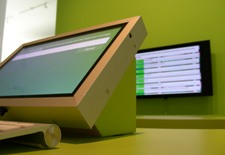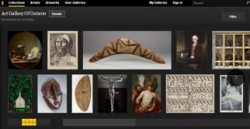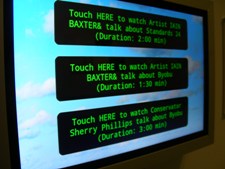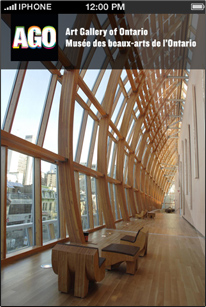A glowing screen, not a covered canvas, is one of the first things you might notice when walking into an art gallery or museum these days.
Mobile technology and digital media devices are taking over the spaces normally reserved for watercolours, oils and clay. In fact, the art itself is migrating to the Web, where online art collections rival those housed inside bricks-and-mortar institutions.
The Art Gallery of Ontario is a leading example; alone among Canadian galleries, it is a participant in the Google Art Project, the search company’s initiative to digitize and make searchable the world’s great art.
More than 30,000 high-resolution paintings, sculptures, and artistic objects can be seen online, along with immersive Street View-type images taken inside many major museums around the world.
Three hundred and sixty-degree image capturing cameras went inside various art institutions, riding atop specially built trolleys, taking shots that were later stitched together to form navigable virtual video tours.
(Currently, the AGO is not featured in this function, although that may change soon. Also, be aware that to use the Google art site at all, you need the Google browser Chrome, or install the Chrome Frame for Internet Explorer plug-in).
Ultra-high resolution cameras have also been used to capture highly detailed images of a limited number of artworks, so site visitors can zoom and scroll through giga-pixel images and see details that gallery visitors cannot.
As engaging as the site is, gallery directors and curators do not want technology to replace the in-person experience, but rather supplement it.
Galleries are slowly and carefully blending traditional artwork and new technology, knowing that computers and Internet connections cannot re-create the full experience of physically visiting a real museum (at least, not for now). Nor can they replace the revenues generated by physical attendance and ticket sales (at least, not for now), but it is an option for viewing art that is otherwise inaccessible, and for extending the experience before or after a physical visit.
So whether online through the Google Art Project, or on-screen using installed tablets and digital media players, additional information is always presented so people can learn more about an artwork, find more works by the artist that created it, and access other related media material.
In the AGO, digital screens of all shapes and sizes can currently be seen – and in some cases, they dominate the Gallery landscape more so than actual framed canvases do.
A case in point is the current exhibition of artwork and interactive projects by the Canadian contemporary artist Iain Baxter&.
(No, that’s not a typo – he has ‘added’ the ampersand sign and word to his name. His name is now pronounced (and legally recognized as) “Baxter-and”, reflecting his collaborative approach to art and his desire for a strong connection with the viewer.)
So, the exhibition makes extensive use of digital technology and social media so visitors and interact and stay engaged with the exhibition.
In the exhibit, there’s a giant ampersand-shaped table, on which sit several mobile tablets, each connected to a dedicated Twitter feed; comments from Gallery visitors are encouraged, and posted to giant LCDs screen nearby (and shared with the artist).
Several other tablets are mounted on the walls and additional video content from and about the artists can be played at the touch of a screen.
Elsewhere in the exhibit, custom-developed QR codes are displayed, so smartphone users can also watch, share and comment on displayed and behind-the-scenes content (the Gallery is Wi-Fi enabled).
Opening up behind the scenes content is a major motivator for another digital initiative at the AGO, as it uses technology to open up its extensive archives (much of any gallery’s art collection is not on display at all times, due to lack of physical space or the requirements of major travelling shows).
Extensive interactivity and several digital screens (iPads, in this case) are used in the new 1,180 sq. ft. David Milne Centre.
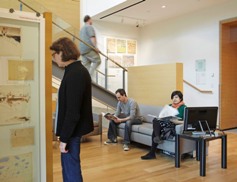
Comfortable seating and large touchscreens make for engaging exhibits, such as the David Milne exhibit at the AGO. Photo courtesy Art Gallery of Ontario.
More than 3,000 sketches, letters, notebooks, early canvases and watercolours from the Canadian artist’s life and career will be accessible through interactive computer technology, visible archives, and video screens.
The AGO has produced some 20 short videos for the Centre, profiling the artist, his personal history, his private world, his professional accomplishments. Visitors can select a documentary from a touch screen menu, relax on the couches provided, and watch as it is projected onto a large overhead screen.
As well, the Milne Digital Archive will soon launch from the main AGO website; it will be the first digital archive of its kind in Canada, with access to over 2,700 works and archival items from the Milne collection.
Gallery visitors will also be interested in the AGO app, developed by Ottawa-based Tristan Interactive, available for compatible Apple devices. It does not interact with other digital projects mentioned here, but it does provide information about current exhibits and ways to engage with other works from the AGO Collection.
* * *
submitted by Lee Rickwood; Lee is a part-time media technician at the AGO.

